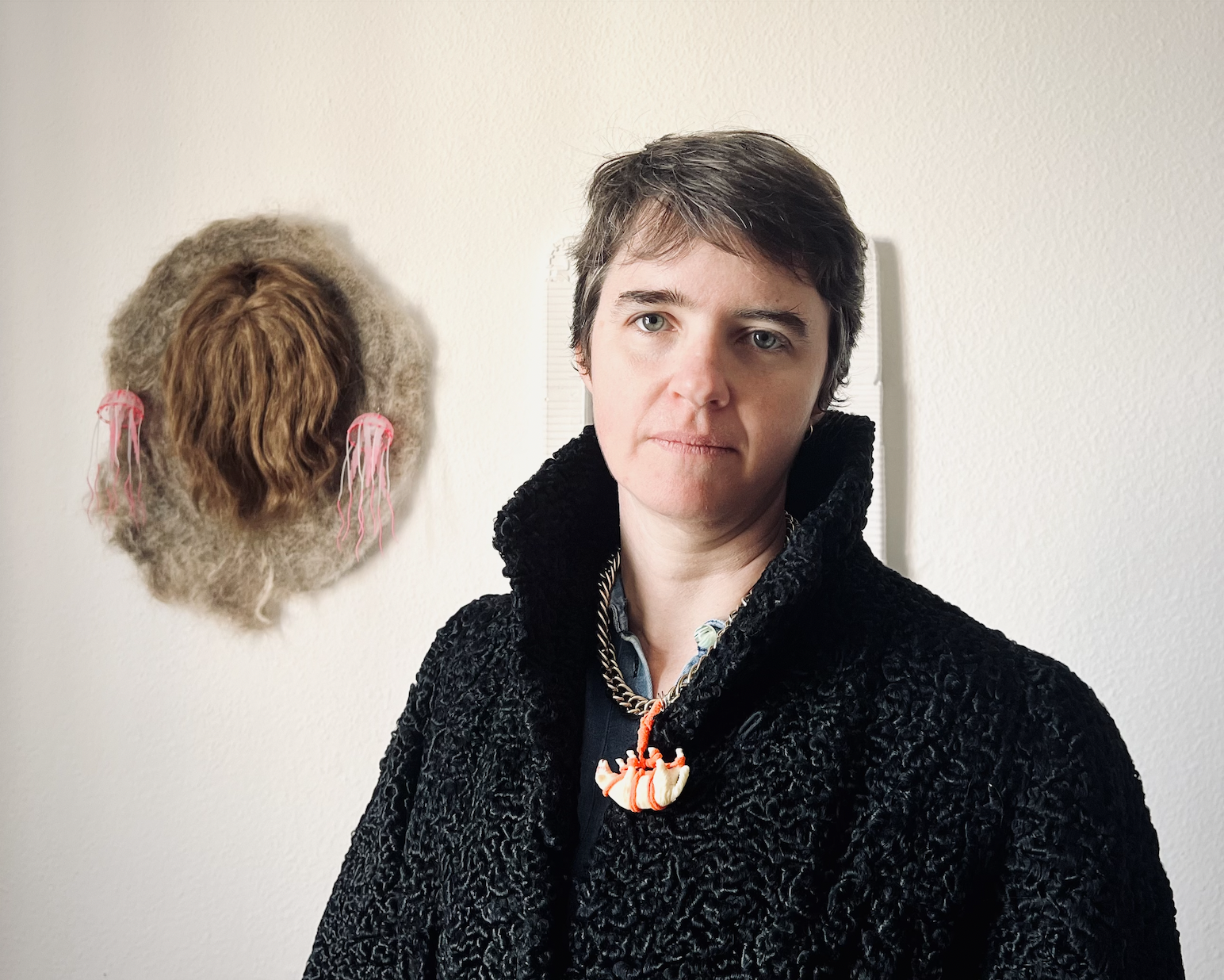
"I do ask myself: why am I turning people in?"
Jade carefully picks up a pink silicone cake mold, which is modeled on a cerebral hemisphere. Jade carefully scrapes out a thin white layer and collects it in a small bottle. Then we turn on the microphone and ask what Jade is doing and why :) With this audio series, we'd like to introduce you to people who can take a leaf out of our book when it comes to the question: What do you actually do in a Playspace? Because they come with many challenges. How do I get in touch with people? What should I pack for this? Should I plan something or spontaneously see what works? We were lucky enough with Jade...

Inspiring restraint - not only in Japanese. Cultural and historical links to bondage
"[...] it matters what stories we tell to tell other stories with; it matters what knots knot knots, what thoughts think thoughts, what ties tie ties."
- Donna Haraway
Anyone who has tasted bondage blood and wants to learn more about the techniques, schools and origins of bondage practices beyond improvised tying with a bathrobe belt will sooner or later come across the Japanese arts of restriction Shibari or Kinbaku. The Hojojutsu practices of the samurai, which date back to the Japanese Middle Ages and were used to overpower opponents by tying them up with ropes, are then referred to straight away. We learn that shibari/kinbaku developed organically from everyday Japanese culture, which is based entirely on binding, as kimonos and gifts are also tied with a furoshiki. In his highly acclaimed book "The Beauty of Kinbaku", Master "K" never tires of emphasizing how closely shibari/kinbaku is linked to Japanese...
INDEX
-
August 2023
- Aug. 22, 2023 Devouring, digestion and cocoreç Aug. 22, 2023
-
July 2023
- July 3, 2023 "I do ask myself: Why am I turning people in?" July 3, 2023
-
April 2023
- Apr 22, 2023 Workshopsexuality. Part I Apr. 22, 2023
- Apr. 21, 2023 Workshopsexuality. Part II Apr. 21, 2023
- Apr. 20, 2023 Workshopsexuality. Part III Apr. 20, 2023
- Apr. 19, 2023 Workshopsexuality. Part IV Apr. 19, 2023
-
August 2022
- Aug. 23, 2022 Tantric massage: Decluttering, Recluttering & Beyond - A TWAPOS experience Aug. 23, 2022
-
July 2022
- July 30, 2022 Salt With A Pinch Of Tantra July 30, 2022
- July 21, 2022 On Being Unenthusiastic About Enthusiastic Consent - New Zine by Beata July 21, 2022
-
January 2022
- Jan. 11, 2022 Calling A Sex-Positive Community, Group or Event a "Family" - And Why It Is A Red Flag - New Zine by Beata Jan 11, 2022
-
December 2021
- Dec. 1, 2021 But I'm a Creep. A lab report. Dec. 1, 2021
- October 2021
- September 2021
-
April 2021
- Apr 10, 2021 Cookie Consent Apr 10, 2021
-
January 2021
- Jan. 2, 2021 Selfhelp zine for the time AFTER an exciting workshop Jan. 2, 2021
-
December 2020
- Dec. 31, 2020 Intimate Interviews Part II Dec. 31, 2020
- Dec. 22, 2020 Video interview by the Goethe-Institut China with Beata on "Pornography & Society" Dec 22, 2020
-
November 2020
- Nov. 11, 2020 The inner playground. An audio journey by Tim Holland Nov. 11, 2020
-
October 2020
- Oct. 29, 2020 Daniela Reina Téllez On The Power Of Workshops And Circles Oct. 29, 2020
- Oct. 20, 2020 Sex /vs./&/?/ violence. Attempt at a conceptual delimitation based on demarcation Oct. 20, 2020
-
September 2020
- Sept. 18, 2020 Testimonial for our workshop "Trial & Eros" by Claire Sept. 18, 2020
-
August 2020
- Aug. 6, 2020 "Sex & Food" - Beata in a podcast talk with Nicole Siller Aug. 6, 2020
-
June 2020
- June 23, 2020 Intimate Interviews Part I - The connection between art and desire and a workshop request concert June 23, 2020
- June 15, 2020 Lonely surfaces - sexual enhancement on the touchscreen June 15, 2020
-
May 2020
- May 3, 2020 Sexmoralism - Compulsory Sex - Sexpositivity - Sexnegativity May 3, 2020
-
March 2020
- March 18, 2020 Inspiring restriction - not only in Japanese. Cultural and historical links to bondage March 18, 2020
-
February 2020
- Feb. 24, 2020 Clauses. A self-reflection Feb. 24, 2020
-
January 2020
- Jan. 15, 2020 Beyond 'sex-positive' and 'sex-negative' Jan 15, 2020
-
November 2019
- Nov. 27, 2019 Deguiltification - Experiential Essay By Chris Ifso Nov 27, 2019
- Nov. 10, 2019 Forensic Sexualities. Some thoughts on shame Nov. 10, 2019
-
September 2019
- Sept. 25, 2019 'Look what marketing's done to my body' - On the compulsion of (not so) creative self-marketing Sept. 25, 2019
-
July 2019
- July 9, 2019 Eclectic experiment on un/security (work in process) July 9, 2019
-
Juni 2019
- June 24, 2019 Wellness and exorcism. An attempt to answer the question of what makes a session valuable June 24, 2019
-
April 2019
- Apr 28, 2019 The Ropes That Mean The World. Reflections on the EURIX - Rope Artist Intl. Performances Spring 2019 Apr. 28, 2019
- Apr 6, 2019 "Always this disgusting sex". To read the reviews of Jan Bonny's 'Winter's Tale' Apr 6, 2019
-
March 2019
- March 27, 2019 A mixed bag, please! Definition difficulties March 27, 2019
- March 20, 2019 Enduring the weird. Reflections after a workshop March 20, 2019
-
Juli 2018
- July 10, 2018 Some Thoughts On The Empowering Sensual Objectifications In Contact Improvisation July 10, 2018
TAG CLOUD
- An Orgy
- Anna Mense
- Kind
- Audio
- Autophagy
- BDSM
- Beata
- beata
- Bondage
- Brainstorming
- Center for Positive Sexuality
- CI
- cluttering
- Consent
- Creepyness
- Critical Sexpositivity
- criticism
- Cultural Theory
- decluttering
- Definition of
- Deguiltification
- Empowerment
- Enhancement
- EnthusiasticConsent
- Expectations
- Felix Ruckert
- Female Pleasure
- Feminism
- Shackles
- Feuilleton
- Fluent
- FOMO
- freedom
- FRIES
- Goethe-Institut China
- gotta fuck
- Boundaries
- Growing Old
- History
- Wood market
- humor
- Independency
- Interview
- Intimacy
- Kinbaku
- Consensus
- Criticism
- Cultural history
- Art
- Body
- Body nouns
- luhmen d'arc
- luhmen d'arc studio
- luhmendarc
- Desire
- Martha Nussbaum
- matis
- Matís d'Arc
- Metaphor
- newage
- Orgy
- Podcast
- Positivity terror
- Prude shaming
- Queer Contact Improvisation
- Rape Play
- rebecca
- Reflection
- Rules
- retreat
- Review
- Risk-aware space
- Rules
- Safe(r) Space
- Shame
- Selfhelp
- Session
- Sex
- Sex technologies
- Sex negative
- Sex positive
- Sexuality
- Sexuality
- Shame
- Shibari
- Security
- Smart devices
- Solidarity
- spain
- tantra
- tantric massage
- tantrawithapinchofsalt
- Testimonial
- Touch & Play
- Uncertainty
- Devour
- When
- Workshop
- Workshopsexuality
- Zine

